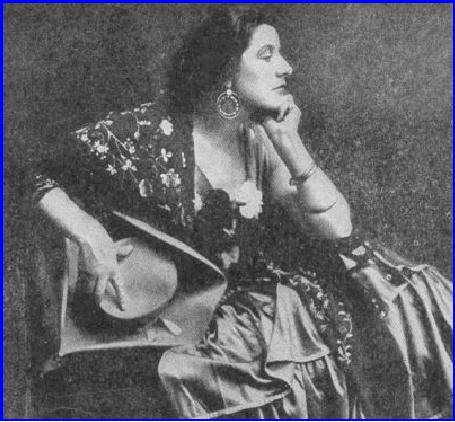 |
MODELS |
| << NATIONALITY IN COSTUME |
| WOMAN COSTUMED FOR HER WAR JOB >> |

blood.
The crude colour of the
national costume and the sharp
contrast in the folk
music
are equally expressions of national
character, the various art
expressions of
which open
up countless enticing
vistas.
The
contemplation of some of these
vistas leads one to the
conclusion that woman
decorative
is so, either as an artist
(that is, in the mastery of
the science of line
and
colour,
more or less under the
control of passing fashion), or in
the abandonment to
the
impulse of an untutored, unconscious,
child of nature. Both can be
beautiful; the
art
which is so great as to conceal conscious
effort by creating the
illusion of
spontaneity,
and the natural unconscious
grace of the human being in
youth or in
the
primitive state.
CHAPTER
XXVII
MODELS
N
historical
interest attaches to fashions in
women's costuming, which
the
practised eye is quick to distinguish,
but not always that of
the
novice.
Of course the most casual and indifferent
of mortals recognises
the
fact when woman's hat
follows the lines of the
French officer's cap,
or
her
coat reproduces the Cossack's, with
even a feint at his
cartridge belt; but
such
echoes
of the war are too
obvious to call for
comment.
PLATE
XXXII
Madame
Geraldine Farrar as Carmen.
In
each of the three presentations of
Madame
Farrar
we have given her in
character, as
suggestions
for stage costumes or
costume
balls.
(By courtesy of Vanity
Fair.)

Courtesy
of Vanity Fair
Mme.
Geraldine Farrar in Spanish
Costume as Carmine
It
is one of the missions of art to make
subtle the obvious, and a
distinguished
example
of this, which will illustrate
our theme,--history mirrored by
dress,--was
seen
recently. One of the most
famous among the great
couturières of Paris, who
has
opened a New York branch
within two years, having
just arrived with
her
Spring
and Summer models, was showing
them to an appreciative woman, a
patron
of
many years. It is not an
exaggeration to say that in all
that procession of
costumes
for cool days or hot,
ball-room, salon, boudoir or
lawn, not one was
banal,
not one false in line or its
colour-scheme. Whether the
style was Classic
Greek,
Mediæval or Empire (these prevail), one
felt the result, first of an
artist's
instinct,
then a deep knowledge of the
pictorial records of periods in dress, and
to
crown
all, that conviction of the
real artist, which gives
both courage and discretion
in
moulding textiles,--the output of
modern genius, to the purest
classic lines. For
example,
one reads in every current
fashion sheet that beads
are in vogue as
garniture
for dresses. So they are,
but note how your
French woman treats
them.
Whether
they are of jet, steel,
pearl or crystal, she
presses them into service as
so
much
colour,
massing them so that one is conscious
only of a shimmering,
clinging,
wrapped-toga effect, à la Grecque,
beneath the skirt and bodice of
which
every
line and curve of the
woman's form is seen.
Evidently some, at least, are to
be
gleaming
Tanagras. Even a dark-blue
serge, for the motor,
shopping or train, had
from
hips to the bust parallel
lines of very small
tube-like jet beads, sewn so
close
together
that the effect was that of
a shirt of mail.
The
use of notes of vivid colour
caught the eye. In one case,
on a black satin
afternoon
gown, a tiny nosegay of forget-me-not
blue, rose-pink and
jessamine-
white,
was made to decorate the one
large patch-pocket on the
skirt and a lapel of
the
sleeveless satin coat. Again on a
dinner-dress of black Chantilly lace,
over
Table of Contents:
- A FEW HINTS FOR THE NOVICE WHO WOULD PLAN HER COSTUMES
- THE LAWS UNDERLYING ALL COSTUMING OF WOMAN
- HOW TO DRESS YOUR TYPE
- THE PSYCHOLOGY OF CLOTHES
- ESTABLISH HABITS OF CARRIAGE WHICH CREATE GOOD LINE
- COLOUR IN WOMAN'S COSTUME
- FOOTWEAR
- JEWELRY AS DECORATION
- WOMAN DECORATIVE IN HER BOUDOIR
- WOMAN DECORATIVE IN HER SUN-ROOM
- I. WOMAN DECORATIVE IN HER GARDEN:WOMAN DECORATIVE ON THE LAWN
- WOMAN AS DECORATION WHEN SKATING
- WOMAN DECORATIVE IN HER MOTOR CAR
- HOW TO GO ABOUT PLANNING A PERIOD COSTUME
- I. THE STORY OF PERIOD COSTUMES:II. EGYPT AND ASSYRIA
- DEVELOPMENT OF GOTHIC COSTUME
- THE RENAISSANCE
- EIGHTEENTH CENTURY
- WOMAN IN THE VICTORIAN PERIOD
- SEX IN COSTUMING
- LINE AND COLOUR OF COSTUMES IN HUNGARY
- STUDYING LINE AND COLOUR IN RUSSIA
- MARK TWAIN'S LOVE OF COLOUR IN ALL COSTUMING
- THE ARTIST AND HIS COSTUME
- IDIOSYNCRASIES IN COSTUME
- NATIONALITY IN COSTUME
- MODELS
- WOMAN COSTUMED FOR HER WAR JOB
- IN CONCLUSION